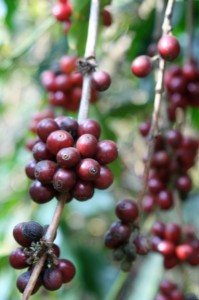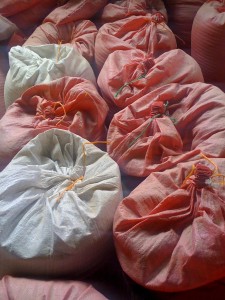 On October 9-12, Sustainable Harvest®’s 12th-annual Let’s Talk Coffee® conference outside Panama City will bring together more than 500 stakeholders throughout the specialty-coffee supply chain, including roasters, producers, and financiers. Leading up to the event, we’re profiling some of the people and elements that make Let’s Talk Coffee® an unforgettable, one-of-a-kind event.
On October 9-12, Sustainable Harvest®’s 12th-annual Let’s Talk Coffee® conference outside Panama City will bring together more than 500 stakeholders throughout the specialty-coffee supply chain, including roasters, producers, and financiers. Leading up to the event, we’re profiling some of the people and elements that make Let’s Talk Coffee® an unforgettable, one-of-a-kind event.
With a coffee industry known for its capability to produce beans of the highest caliber, Panama is a fitting setting for Let’s Talk Coffee®, which will offer three days of forward-thinking content around market volatility, climate change, and other pressing coffee topics, as well as a visit on the fourth day to some of Panama’s highest-quality coffee farms.
 As the industry prepares to descend on Panama for the event, it’s worth taking a look at what makes the nation so special.
As the industry prepares to descend on Panama for the event, it’s worth taking a look at what makes the nation so special.
First, let’s look at its history. Despite its century-old coffee cultivating tradition, this southernmost Central American nation was essentially unknown to the international coffee world before seven growers from the Boquete and Volcan-Candela regions formed the Specialty Coffee Association of Panama (SCAP) in 1996. The move was a reaction to producers seeing prices plummet in the 1990s as cultivation of low-grade coffee expanded rapidly in southeast Asia. SCAP set out to help its members differentiate and market their exceptional beans.
Jump ahead 15 years, and Panama’s coffees are renowned for their phenomenal flavor profiles and quality, with select micro-lots bringing in record sums at auction. The nation’s output remains relatively small, exporting 4.4 million pounds of green beans from July 2013 to June 2014. (To offer some context, Panama’s exports equal 3% of its neighbor Costa Rica’s production over the same period.)
Any conversation about Panamanian coffee must include a discussion of Geisha, as the nation’s ascendance on the world coffee stage is concurrent with the rise of the coveted heirloom variety, whose name and reputation have reached mystical proportions among aficionados. An heirloom from coffee’s birthplace in the Ethiopian highlands, Geisha came to Panama via Costa Rica in the 1960s.
 For decades, little attention was paid to this particular variety, and farmers planted it interspersed with other types. But as consumer appreciation for distinct coffees began developing, SCAP producers took note of their Geisha plants, which had distinct morphology—wide stems and large, elliptical cherries—and whose beans would, with care, produce flavor profiles without equal. In the cup, Geisha exhibits pronounced jasmine and floral aromas, delicate acidity, balanced and bright with notes of white wine, berries, mango, papaya, mandarin oranges, and a distinct bergamot finish. (Let’s Talk Coffee® 2014 will include a Geisha panel and keynote address, followed by a coffee tasting and a Geisha-themed board game created for the event.)
For decades, little attention was paid to this particular variety, and farmers planted it interspersed with other types. But as consumer appreciation for distinct coffees began developing, SCAP producers took note of their Geisha plants, which had distinct morphology—wide stems and large, elliptical cherries—and whose beans would, with care, produce flavor profiles without equal. In the cup, Geisha exhibits pronounced jasmine and floral aromas, delicate acidity, balanced and bright with notes of white wine, berries, mango, papaya, mandarin oranges, and a distinct bergamot finish. (Let’s Talk Coffee® 2014 will include a Geisha panel and keynote address, followed by a coffee tasting and a Geisha-themed board game created for the event.)
The Geisha variety is rightfully celebrated, but its development in Panama only partially explains why the country’s coffees are so special.
 Centered around the dormant Barú Volcano in the western highlands province of Chiriqui, Panama’s coffee farms benefit from the region’s unique terroir. Moisture from the tropical Pacific and Caribbean Sea meet in the nation’s mountainous center, producing misty year-round rains that drain through rich volcanic soils. At 11,000 feet above sea level, Barú is Panama’s highest peak, and its slopes allow growers to cultivate coffee at elevations as high as 6,000 feet, where cool nights mean coffee cherries mature slowly, developing extraordinary complexity.
Centered around the dormant Barú Volcano in the western highlands province of Chiriqui, Panama’s coffee farms benefit from the region’s unique terroir. Moisture from the tropical Pacific and Caribbean Sea meet in the nation’s mountainous center, producing misty year-round rains that drain through rich volcanic soils. At 11,000 feet above sea level, Barú is Panama’s highest peak, and its slopes allow growers to cultivate coffee at elevations as high as 6,000 feet, where cool nights mean coffee cherries mature slowly, developing extraordinary complexity.
A culture of careful cultivation, harvesting, and processing—of paying attention to the earth and being sensitive to the natural environment—is pervasive among Panama’s coffee growers. SCAP now has 30 member farmers who cultivate Geisha, Typica, Caturra, Catuai, and other varieties, and most of whom produce award-winning coffee. SCAP has helped foster collaboration among its members through national competitions and international auctions, and growers have dedicated their work to producing some of the best coffee on earth, developing an archetype for the sector’s top tier to study and follow.



.png)
